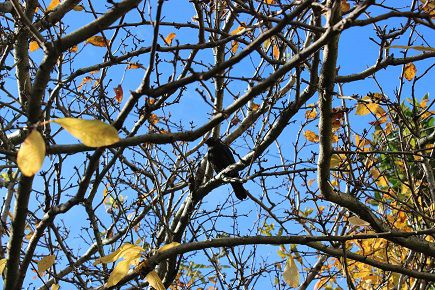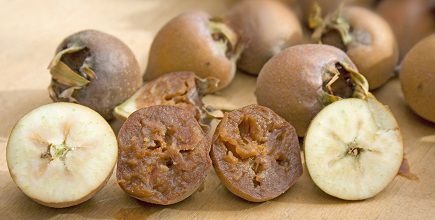WHAT OF THE MEDLAR?
- 12 June 2017
- KMHG Webmaster
At Katherine Mansfield House & Garden there is a tree that is perhaps often overlooked. Leaning over the driveway, it sheds fruit every autumn. It’s the medlar tree, a tree with deep roots in history and literature - mentioned by everyone from Shakespeare, Chaucer to D.H. Lawrence.

Image: A bird enjoying the view from the branches of the medlar tree at Katherine Mansfield House & Garden.
The medlar’s Latin name, Mespilus germanica, implies a European origin. But actually this tree originates from Southwest Asia. It’s part of the Rosaceae family, which most obviously includes roses but also many other fruit trees such as quinces, apples, and pears.
Eating the medlar can be a challenge. The regular fruit is hard and tart. The best way to prepare it is ‘bletting’ - taking the fruit off the tree, and allowing it to ripen in a cool place. This turns the medlar flesh from hard white to a mushy brown. The uses for medlars are surprisingly numerous for such a little known fruit, you can use them in jams, eat them with cheese, make medlar curd by mixing them with eggs and butter, even make them into tea! In medieval England (after gardeners painstakingly introduced the tree to the country) some people ate the fruit mashed into a pulp and mixed with honey.

Image: Medlar fruit, shown semi-mature (white flesh) and fully ripe (brown flesh). Courtesy of Wikimedia Commons.
References to medlars in classical literature often play on the bletting process, with the medlar being used as a symbol of rottenness. For example, in the Jacobean play The Honest Whore by Thomas Dekker a character (somewhat cruelly) opines that “women are like medlars, no sooner ripe but rotten.” Katherine Mansfield’s friend D.H. Lawrence evidently wasn’t a fan of medlars, describing them as “wineskins of brown morbidity, autumnal excrementa ... an exquisite odour of leave taking". The medlar was also used for more bawdy humour, with it being nicknamed "open-arse" because of its shape. Shakespeare references this in Romeo & Juliet with Mercutio describing Romeo pining for Rosaline:
Now will he sit under a medlar tree,
And wish his mistress were that kind of fruit
As maids call medlars, when they laugh alone.
O Romeo, that she were, O that she were
An open-arse and thou a pop'rin pear!
Shakespeare references the medlar frequently. In As You Like It, Rosalind threatens to graft Touchstone to a medlar tree:
Rosalind: I’ll graff it with you, and then I shall graff it with a medlar: then it will be the earliest fruit i’ the country; for you’ll be rotten ere you be half ripe, and that’s the right virtue of the medlar.
Touchstone: You have said; but whether wisely or no, let the forest judge.
Isn’t it interesting how something so overlooked can have such significance? Medlar seeds have been found in Italian archaeological sites, and the fruit has been found referenced in mosaics in Pompeii.
Interested in giving medlars a try? Here’s a recipe from Robert May’s The Accomplisht Cook, published in 1660.
“Take medlars that are rotten, strain them, and set them on a chaffing dish of coals, season them with sugar, cinamon and ginger, put some yolks of eggs to them, let it boil a little, and lay it in a cut tart; being baked scrape on sugar.”
References:
"Medlar Care Guide” - ediblelandscaping.com
“Mouldy Medlar” - notjustdormice.wordpress.com
“Medlar: The Best Fruit You’ve Never Heard Of” - rootsimple.com
“Ugly, But Tasty, Old Fruit” by Lee A. Reich - from leereich.com
“Medieval English Gardens” by Teresa McLean
“Einstein’s Beets: An Examination of Food Phobias” by Alexander Theroux
“Shakespeare's Medlars” from ars-grin.gov
